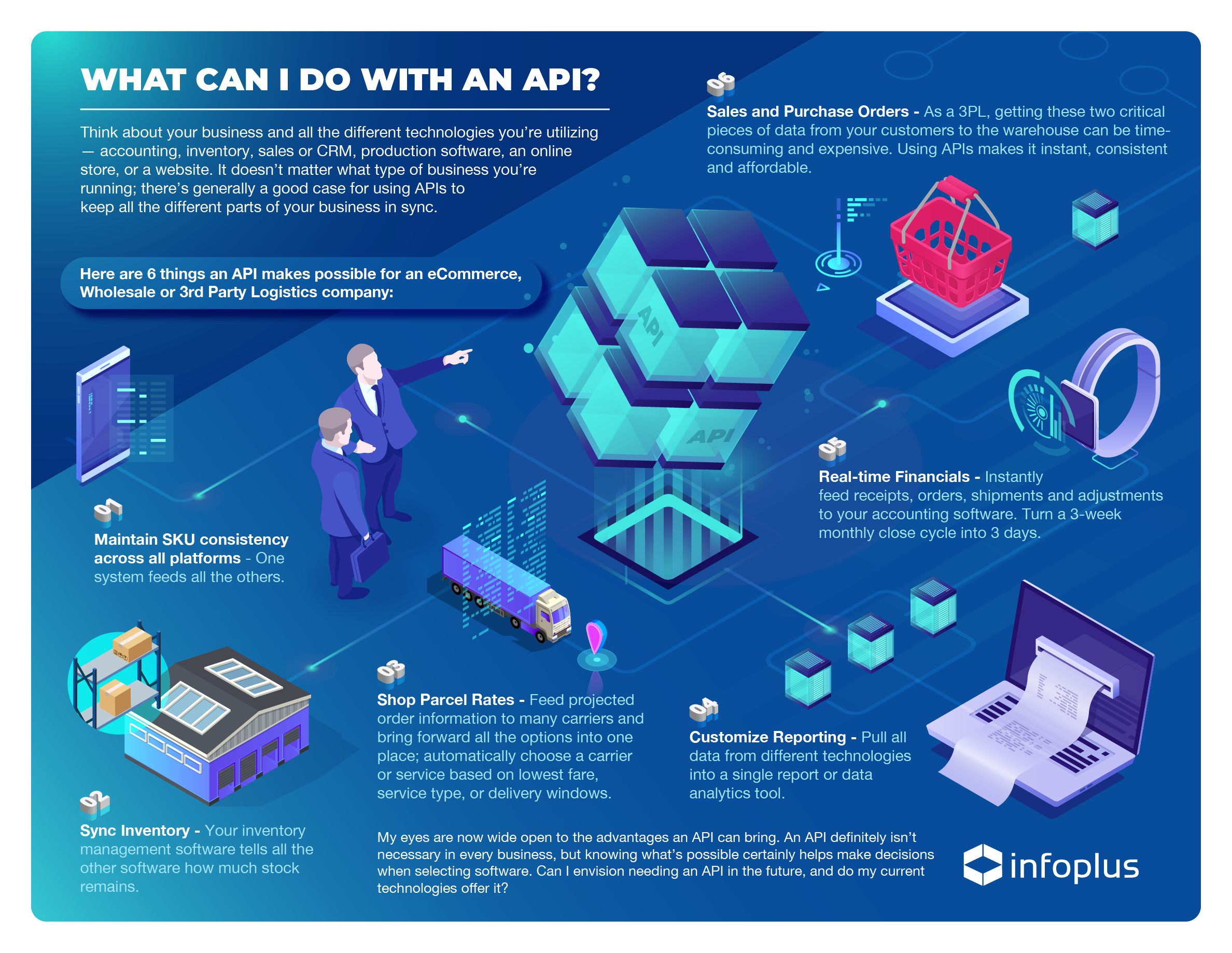5 Ways to Increase Sales with your API

You’ve established yourself as a reliable, competitive warehouse fulfillment center. You’re ready to push for #1, but are mediocre sales holding you back?
If so, there’s a solution: a Warehouse Management System Application Program Interface—or WMS API for short.
Warehouse Management System Application Program Interface
This API can turn your less-than-stellar fulfillment into profit-churning sales ... if used correctly. From making a powerful first impression on new customers to seamlessly managing your inventory, we’ve made a quick-start guide of five simple ways you can increase sales with your API.

1 - Track More than Just Your Shipments
Did you know? It costs 7 times more to get a new customer than it does to keep them. You’ll see great returns by creating a user-friendly atmosphere that makes it easy for your customers to return to you.
Think about the restaurants, stores, services, etc. that you use on a regular basis. I’m willing to bet that, in most cases, your experience is pleasant and hassle-free. If you treat your customer to on-demand updates on their order by using a real-time API, this ensures that you—and the customer you just gained—can track orders and goods as they are picked, packed, and shipped without the hassle of manual intervention.
Even in 2019, pre-packaged reports are the norm—some top-of-the-line SaaS businesses still make it difficult for customers to extract their own data! But both you and your customer deserve more than “the norm.” That said, going beyond “the norm” often leaves you missing a key field or wishing data from two systems were consolidated. A superior API will show you EVERYTHING in one place, providing the tools and ability to turn your customers into raving fans.
Give your customers real-time visibility for their order with the API and your online shopping cart. Don’t be surpassed by the pizza place, with their to-the-minute updates on the status of your pizza. Instead, update your customers with instant, easy-to-access info: “John D just picked your order, and it’s currently being packed by Susan H.” Just think of it as Shipment Tracking—but within your warehouse walls.
2 - Turn First-Time Customers into Life-Long Customers
A great API equips you to make every customer feel like they’re your only customer. Utilize your API to automate custom packaging, gift messages, additional services, and shipping. For example, use your API to tag first-time customers and send their orders down a special “first-time customers” packing and shipping line. There you can include additional marketing inserts, special packaging, and a welcome package. Then, use the same approach to reward your repeat customers with a slightly different experience.
Check out this stat: 89% of U.S. consumers say that they return to brands that share their values and personalize their experience. With a good API, that personalization can be all be automated. Why not take advantage?
3 - Never Miss a Special Occasion
Want to know more hassle-free ways you can utilize a strong API to treat your customers like royalty? Use your API to sync your CRM data into your WMS and auto-generate birthday or anniversary orders for the top ten percent of your customers. Send them a special gift and a handwritten card.
You may not realize it, but little things like this can be done without any extra work on your part. They’ll go a long way towards increasing customer retention, too. With the right API, it’s all just a part of your standard production line.
4 - Follow Vegas and the Airlines’ Example
Every customer is special, but let’s be real; some are more special than others. Airline companies and Vegas know this; they’ve built entirely separate channels and operations for their top customers. You should, too. And thanks to a great API, it’s easy.
Inform your operations of your top clients’ status with your API. Then, you can automatically process those client orders down expedited lines or introduce custom data, inserts, or behaviors for those clients. This process ensures that you’ll never drop the ball on an A-list client. You’ll place yourself in a favorable light for their future purchasing decisions. Always consider our man Pareto; 80% of your business comes from 20% of your customers.
5 - Sell What You Have (and Not What You Don’t)
You have a warehouse full of great items that your customers need—yet sometimes you lose [HB5] customer satisfaction by bringing in orders for out of stock items. It might seem obvious, but I’ll say it anyway: You should always know what you have too much of and what you need more of. Stay on the ball and use the API to access real-time analytics of your WMS and inventory.
Bonus - More Tips and Tricks?
A great API will help automate your marketing campaigns. You’ll ramp up sales based on a combination of key data:
Inventory is behind/inbound containers are caught up in customs:
Use the API and real-time inventory to remove those items from sales or campaigns until your “Days On Hand” inventory levels meet non-backorder levels.
Too much inventory:
The API tells you when it’s time for a sale or campaign for items that are costing you money to hold on hand.
Slow days/uneven workflow:
Allow the API and labor-tracking tools to target slow periods and even out your flow. Run a campaign on specific, targeted days to combat idle labor.
Some days are too heavy:
As the old saying goes, “under-promise and over-deliver.” Use the API to track in real-time the warehouse order load and remove same-day or next-day service levels as your production queue fills to capacity. Maintain the sales, but remove the unattainable delivery timeline.
Is your inventory behind schedule? Are inbound containers caught up in customs?
Avoid the dreaded “This item is out of stock” or “On Backorder” warnings with your API. The API works with your real-time inventory to remove those missing items from your sales or campaigns until your “Days On Hand” inventory levels meet non-backorder levels.
Too much inventory?
A surplus isn’t uncommon, and the API can alert you when items are costing you money to hold on hand. Then you can set up a sale or campaign to clear the surplus stock.
Plagued by uneven workflow or slow days?
The API can solve that, too. Allow your API and labor-tracking tools to target slow periods and even out your flow. Know when to run a campaign on to combat idle labor.
What’s worse than slow days?
Days that are too heavy. As the old saying goes, “under-promise and over-deliver.” Your API can help you over-deliver by tracking in real-time your warehouse’s order load. The API will remove same-day or next-day service levels as your production queue fills to capacity. Maintain the sales, but remove the unattainable delivery timeline.
.png?width=225&height=60&name=Logo%20(7).png)


